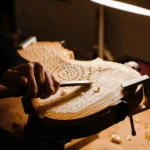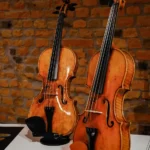The Top 10 Italian Violins
Back to BlogHaving existed for centuries in the world, these classical instruments have a long history and there is one place responsible for bringing the best makers of all time and, consequently, the best instruments. We are talking about Italy! As the violin evolved, different famous Italian violins were born. Names such as Amati, Stradivari, Bergonzi, Guarneri, and so many others did their part and brought the violin into the spotlight, making it one of the most popular and valuable instruments in the world. Valuable in its quality and importance in music.
Our list was carefully selected to be in this blog post, gathering some of the greatest names in Italian violin making, we tried to bring you some insight into this amazing history.
Let’s go to the Top 10 Italian Violins:
Carrodus, 1743 by Guarneri ‘del Gesù’
The Carrodus Guarneri Violin was named after one of its owners, 19th-century British violinist John Tiplady Carrodus (1836-1895). It is considered to be one of the finest violins made by Guarneri. Interesting fact: The Carrodus was made from the same tree as GdG Il Cannone, owned by Paganini. Since January 2007, the violin has been in the hands of Australian Chamber Orchestra’s artistic director Richard Tognetti.
The number of surviving instruments made by Guarneri del Gesù is estimated to be around 150, different from other sought-after violin makers like Stradivari, who made nearly 600 violins. These violins are rare because Guarneri del Gesù had a short life, not only focused on violinmaking, and turned his works of art into rare pieces high in value. Nevertheless, he worked for 16 years as a violin maker, resulting in roughly 10 instruments per year, which is, actually, quite a reasonable rate compared to the other prolific makers in the 1700s, not to mention the other instruments that haven’t survived in the long run.
COPY OF JOSEPH GUARNERI “DEL GESÙ” CARRODUS, 1743 by Luiz Amorim
The master maker of Amorim Fine Violins, Luiz Amorim enjoys making ‘del Gesù’ copies and mastered it!
Guarneri’s expressive work, highly admired by Luiz, is faithfully printed throughout the violin. In our opinion, Luiz’s artistry representing all of the details of the original instrument alongside its one-piece of quarter-cut maple grabs anyone’s attention.
The luminous one-piece back maple with wide, deep flames comes from the Balkans. The sides follow the same figure as the back and the neck with slightly narrow flames. This violin is ready to be played by an excellent musician.
Nicolò Amati, Cremona, 1641, the ‘Hambourg’
The masterpiece appeared at Beare’s shop, and the instrument was immediately recognized by the authors as one on which Amati had worked on in the 17th century.
Nicolò Amati, the grandson of Andrea Amati, inherited his father’s workshop after the plague devastated 1/3 of northern Italy’s population. The workshop of Amati was already a large-scale business that supplied musical instruments to the most demanding musicians of the 17th century. In addition to making instruments; cases, bows, and accessories were all produced there. This made him need assistants in the making, which later resulted in many young men passing through his workshop, learning and disseminating his method across European lands.
The Lipinski Stradivarius
The story has a relation with the Devil itself! Giuseppe Tartini its owner woke up frustrated by his inability to play what the Devil had played on his violin during his dreams, Tartini persevered, and his persistence finally paid off with the composition of his Devil’s Trill Sonata. Several years later, Tartini acquired a beautiful Stradivarius violin, which was capable of giving the best of the Devil’s Trill Sonata.
Made in 1715, the violin carries the name of the ‘Lipinski’ Stradivarius, the name of a great Polish violinist, Karol Lipinski. It is said he played along with Paganini in concerts during 1818. However, after his death in 1861, the instrument came into the possession of the Roentgen family. Today, Milwaukee Symphony Orchestra concertmaster Frank Almond plays the ‘Lipinski’ Stradivarius.
Undoubtedly, the instrument passed through the hands of amazing musicians, Antonio Stradivari was one of the best violin makers of all times, and his instruments are studied and serve as inspiration today.
According to Tarisio, players such as Angel Reyes, Evi Liivak, Frank Almond, Julius (II) Röntgen, Karel Jozef Lipinski, Louis Persinger played the instrument.
The 1733-35 ‘Kreisler’ – Carlo Bergonzi
The 1733-35 ‘Kreisler’ is an outstanding example of Carlo Bergonzi’s work. Bergonzi was the last of the classical Cremonese luthiers and successor to the workshop of Stradivari. Like the ‘Arditi’ Stradivari violin, this particular instrument can be traced back to the collection of Count Cozio di Salabue, and it is listed in 1841 as one of two Bergonzi violins attributed to Stradivari.
It has passed through the hands of excellent players; Fritz Kreisler, after whom it is named, and Itzhak Perlman. Dextra Musica obtained it in 2006 from the celebrated collector David L. Fulton. The instrument is one of only two surviving Bergonzis that retains its original neck, and the condition throughout is exceptionally fresh. The varnish is abundant and unspoiled, having been left untouched by polishing or retouching.
The ‘Gibson ex Huberman’ – Stradivari
The violin has a curious history. It was stolen twice from its owner, Bronisław Huberman. The first time, the violin was stolen on the musician’s 1916 European tour and was recovered just a few days later. The second time, was during a concert in 1936 when the violinist Bronislaw Huberman was performing at Carnegie Hall. During the second part, the musician changed his Stradivari to a Guarneri, and the instrument was stolen from his dressing room.
Despite investigations, no one knows exactly how and why the violin was stolen in 1936. In 1985, however, a New York violinist named Julian Altman died and made a deathbed confession that helped to solve the crime. Nowadays, the instrument is owned by the great violinist Joshua Bell and the artist has great affection for the instrument, saying it seems to be part of him.
Il Cannone 1743 by Guarneri ‘del Gesù’
The violin, known as Il Cannone, 1743, belonged to Nicolo Paganini, the celebrated 19th-century violinist. He nicknamed the instrument “my canon violin” since he loved its resonant sound. Paganini’s possession of the violin is still uncertain. However, the more probable one is that the violin was bestowed on him by a particular amateur musician and businessman from Livorno in 1802.
The ‘Cannon’ now enjoys a more retired life in the refurbished Sala Paganiniana in Genova’s Palazzo Tursi, under the supervision of the Museums of Strada Nuova. It was refitted in 2004 with copies of the fingerboard, pegs, bridge, and tailpiece used by Paganini and is exhibited with a set of plain gut strings, as the great virtuoso would have played it.
COPY OF JOSEPH GUARNERI “DEL GESÙ” CANNONE, 1743 by Luiz Amorim
A precise copy crafted by a master maker. Luiz’s careful hands and attentive eyes highlight his skills as an artisan by replicating all the precise details of the original one – not to mention the Genova’s city stamp on the back of the scroll. For us, the high point of this violin is the imponent and characteristic volute, capable of easily distinguishing this instrument from others.
The top’s spruce was carefully selected and came from Val di Fiemme, the same source ‘del Gesù’ used to get his wood. The two-piece back maple with medium flames is joint in a v -shape and comes from the Balkans. The violin is ready to be played and to follow you in your successful journey as a musician.
The “Sleeping Beauty” Stradivarius violin of 1704
This violin is dated either 1720 or 1729, but it is believed to have been made in 1704. Its quality is evident in its perfectly cut f-holes, majestic scroll, and precise purfling. The wood resembles that found in the “Betts” of 1704, leading experts to believe that it was made in the same year.
It is believed the buyer was Baron Franz Wolfgang von Boeselager Zu Nehlen, who was in Italy around 1724. The most curious fact is that the violin was apparently forgotten for about 150 years in a family attic, before being rediscovered and played again in 1900 by Max’ von Boeselager.
The Dolphin Stradivarius, 1714
This violin, once owned and played by famous virtuoso Jascha Heifetz (1902-1987), was named “Dolphin” because when it was first purchased in the late 1800s, its appearance reminded its owner of a dolphin. The current owner is Nippon Music Foundation, on loan to Japanese violinist Akiko Suwanai.
Sainton 1744 by Guarneri ‘del Gesù’
The violin-making world until that moment had been one of precision and consistency. But the ‘del Gesù’ appeared to challenge this as, guided by experimentation and self-expression, he broke with tradition. A true revolutionary in its design and sound, standing behind only Strad. The Sainton, 1744, by Guarneri del Gesu, was crafted alongside Ole Bull and has a bold design that highlights its creator’s late-period style; this violin contains Guarneri’s distinctive characteristics.
Biddulph calls Sainton a master violin who gives the impression of a hurried maker trying to complete his final instrument while attempting to achieve a convincing acoustical and stylistic result. Once, it was thought not to have been made by ‘del Gesù.’ There were two opposing opinions regarding this fact: one expert believed it authentic, whereas another expert thought the opposite.
COPY OF JOSEPH GUARNERI “DEL GESÙ” SAINTON, 1744 by Luiz Amorim
Follows the Italian traditional handcraftsmanship featuring Luiz’s passions of liberty and expressiveness in a work of art. From our perspective, the main feature of this instrument is the beautiful varnish wear and patina reproduced at the back.
The luminous two-piece back maple with medium, deep flames comes from the Balkans. The instrument is covered by a golden-yellow varnish. It is ready to be played by an excellent musician.
The Bonus Violin!
Not from the list, but we have another great copy of a historical instrument, to be more precise, a copy of another Guarneri ‘del Gesù’, the revolutionary luthier.
COPY OF JOSEPH GUARNERI “DEL GESÙ” CARIPLO, HENNEL, ROSÉ 1744 by Andrea Giovannetti
A detailed copy crafted by a rising star-maker. It follows the best Italian craftsmanship tradition together with Andrea’s personal touch and artistry. In our view, the bold, free-hand cut scroll is the violin’s high point and reveals Guarneri’s late-period style immediately.
The top of the violin is made with spruce from Val di Fiemme with medium, regular grain, and the one-piece back of Bosnian maple with deep and bright flames. The oil-rosin varnish is of brown-red color on a golden-brown ground and emphasizes the tool marks, old patina, and craquelé that give this instrument its typical “gothic” appearance.









